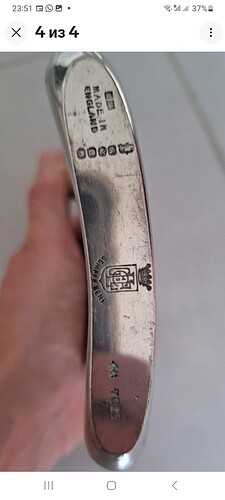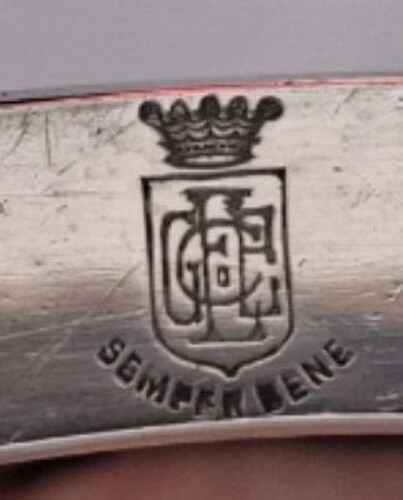I would like to receive information about this flask: material, date of manufacture, whose coat of arms, production, etc
It’s silver plate (not sterling) from James Dixon & Sons, Sheffield. They had a long history (early 19th Century until the 1970’s), so dating their plated items is usually impossible.
ETA: This particular form of mark was used between 1879 and 1935, which narrows it down at least a bit.
Not sure about the crest.
ETA: The motto is “Semper Bene,” which translates as “always well” or “always good.” In other words, “All the best to you.” Fairly generic, alas. And the monogram appears to be “G-something- E Co.,” which indicates that it’s a company name. So, a promotional item, rather than a personal one.
I rather like your re-christening of hip flasks (a name determined solely by shape to tuck on the hip) to “hit” flask which might refer either to its popularity (a hit) or something you could take a swig or “hit” from to something perhaps carried by a “hit” man during prohibition.
In fact, arising out of prohibition whiskey manufacturers used to make hip flasks to sell 1/5th in rather than the standard bottle shape. They are still available.
Flasks, basically containers to carry oil or potable drinking matter, alcoholic or otherwise have been around for ever, certainly into pre history.
The modern curve shape to carry on or next to the body, sometimes on the hip and sometimes tucked into a garter belt on a leg, devolved in the 18th century. Mostly to allow liquor to be carried during hunting expeditions. If you carried liquor you could either drink it when you missed your shot or pour its contents on the wound when you got gored for missing the shot.
They were also popular at horse race meetings for those too cheap to go into the drinks tents and buy a whiskey or too un-badged to be allowed into the members’ tent.
Prohibition saw the mass production of these items the contents of which were added to cups of tea on railroad platform cafes etc.
After use, especially if the liquor in it had been coloured or sugared it would stain the interiors. Victorian standard tips for cleaning including filling the stained flask with washing soda and lead shot and swilling it around. This removed the offending liquor remnants replacing it with a nice even coating of lead. The same cleaning was prescribed for glass decanters often already laced with lead and referred to as lead crystal.
All this led to lead poisoning, the same quick inheritance solution that water pipes and cisterns made of lead had been providing since Roman times in much of Europe.
CRWW
I think you should market a hip flask liquor brand targeted at the distaff and call it “hit and miss”. Fill it with shots of mezcal and make the flask out of glass in the shape and texture of an old oak tree and tie a yellow ribbon round its neck. That las Vegas staple, Sir Thomas Jones can probably still crank out your music for the promo.
CRWW

